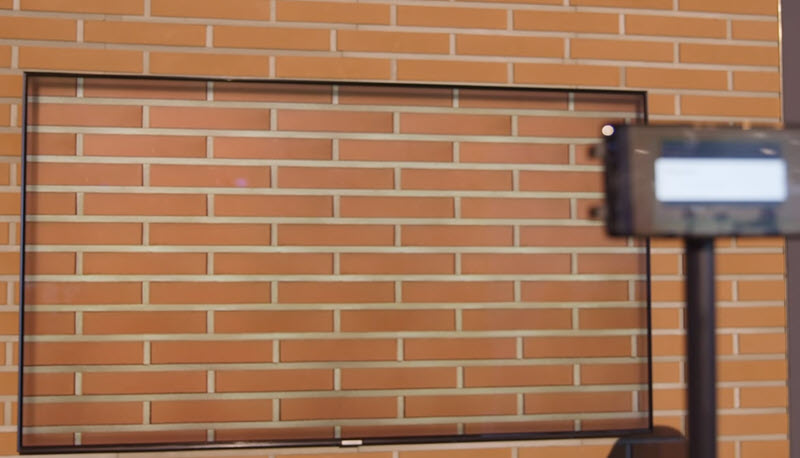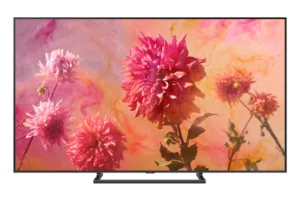Samsung has revealed its QLED TVs at an event in storm battered New York this week and despite the weather, the company claimed 1,000 attendees were at the event.
The Q9F is the flagship series and it is joined by Q8F, Q7F and Q6F models as well. The big story is the improvement in the visual performance, based on the technologies that the company showed in its CES ‘Innovation zone’. The big change is the adoption of Full Array Local Dimming, which is combined with a new anti-reflective black filter film technology, radically improves the black level of the Q9F and Q8F sets as well as the Q7F range and reduces the ‘halo effect’ that caused the company to so often lose shoot-outs in comparison with OLED in 2017. The Q7F and Q6F use edge-lighting with the LEDs at the bottom of the display.
Samsung has also developed its ‘one cable’ technology to add power – last year, there were separate power and data cables, but now there is just a single, very slim cable that can be up to 15m long (5m is supplied as standard), allowing the input box and processing to be away from the display and even in another room.
A feature of the new sets is an ‘ambient mode’ that gets over the ‘black hole on the wall’ problem. (The Black Hole on the Wall). If you take a photo of the TV and its surroundings with a smartphone, the system will create a pattern to match the colour of the area around the TV and show it, reducing the visibility of the TV. Alternatively, there is another mode to allow news or images to be shown – like the ‘Frame’ series TVs.
 Samsung’s Ambient Mode matches images on the screen with the wall. Image:From video capture
Samsung’s Ambient Mode matches images on the screen with the wall. Image:From video capture
There have been big improvements made to the set up process, which is much simpler, exploiting the data that is already in the owner’s phone to allow automatic connection to a lot of OTT services and apps. The TV automatically connects to smartphones in the environment when it boots up, using BlueTooth (Android or iOS). The TVs also use the AI-based scaling technology that was highlighted at CES.
The remote has been improved to allow the single remote to work well with other boxes and devices and the set up is simpler.
Of course, the company also highlighted developments in Bixby for SmartHome integration. It will, of course, connect with SmartThings, as flagged at CES.
Models in the 2018 QLED TV lineup include – Q9F (65”, 75”, 88”), Q8F (55”, 65”, 75”), Q7C (55”, 65”), Q7F (55”, 65”, 75”) and Q6F (49”, 55”, 65”, 75”, 82”). The QLED TVs feature enhanced color and contrast, HDR10+ compatibility, Ambient Mode, Smart TV enhancements with Bixby Voice, One Remote Control and the One Invisible Connection.
As well as the new TVs, there are four new soundbars, with the top of the range HW-N950 featuring 7.1.4 surround sound based on Dolby Atmos.
Calman Integrated
At CES, Portrait Displays was in the Innovation Zone and showing how its auto calibration assistance software (which won the AVS Forum Best of CEDIA 2017 award) is being extended into 2018 and Samsung highlighted that the technology was able to provide an even better solution because of the high colour volume. The technology has been developed and whereas the 2017 models only had colour controls at 100% saturation, the 2018 models also have it at 50% and 75%.
“The added controls allow CalMAN to improve accuracy throughout the color volume, not just at its edges,”
said Martin Fishman, Portrait Displays’ co-CEO
Analyst Comment
For a variety of reasons, we weren’t able to get to the event, so couldn’t dig down to the details of, for example, how many LEDs are in the FALD array (in fact, it explicitly said that it didn’t plan to talk about it as anybody can just add LEDs, the question is, though, how you do this cleverly, without simply adding zones – and cost). However, be sure that we will be digging into the technical details, although most of them were actually covered in our CES report because of the access we had to the Innovation Zone. Samsung Points to 2018 TV Direction, but Short on Detail).
The company did show the set side by side with OLEDs, as it did privately at CES. It also said that all of the QLEDs would have peak brightness of ‘at least’ 1,000 cd/m². It highlighted the ‘colour volume’ of the QLED image – the saturation of high brightness colours and detail in the highlights. The QLEDs are also more efficient, so power consumption has gone down, this year.
After CES, Samsung was not keen to let us show you the graphics it showed us at CES, but the system is a kind of ‘louvre’ which, to me, looked very similar to the kind of design used in outdoor LED, where black protrusions stop ambient light from reflecting. Of course, this kind of design would also help to reduce the halo effect.
Amazon seems to have accidentally released some details of pricing on the new sets, but they seem to be around the same level as last year. When we went to check, the sets had been taken down again. The company highlighted that it has added more sets of over 65″ in the lower series as it still sees increasing demand for bigger sets. (BR)

